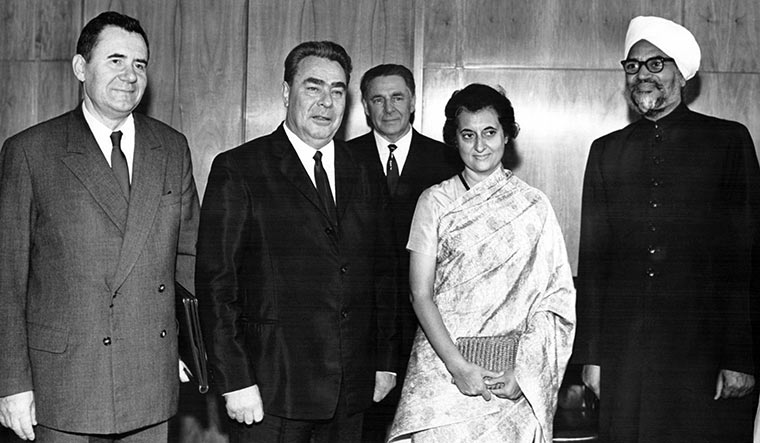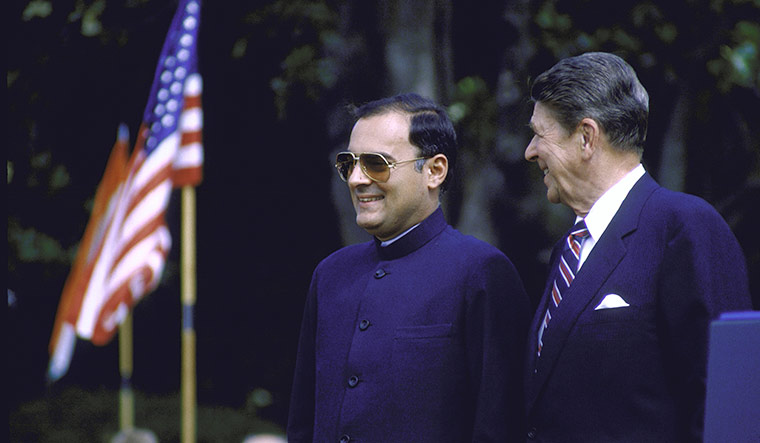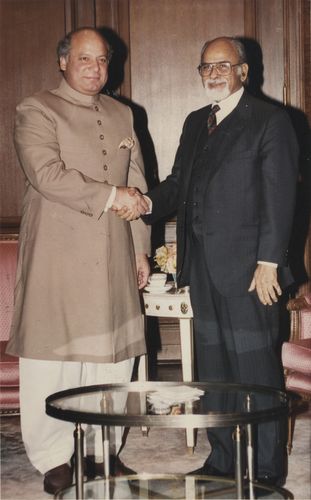From Jawaharlal Nehru’s idealism to Narendra Modi’s pragmatism, Indian foreign policy has traversed a significant distance, marking a break from the past sometimes, but always retaining its essential spirit. Nehru used his charismatic personality to promote India’s image abroad and put emphasis on personal friendships as a means of diplomatic engagement. Despite his pronounced differences with Nehruvian policies, Modi, too, seems to be following the same playbook.
While Nehru remained equidistant from the two superpowers during the Cold War, Modi skilfully navigates today's complex geopolitical scenario marked by pronounced multipolarity. He is at ease working with the US-led Quad (US, India, Australia, Japan) on the one side and the Russia and China dominated BRICS (Brazil, Russia, India, China, South Africa) and the SCO (Shanghai Cooperation Organization) on the other. India’s non-aligned stance during the Russia-Ukraine war is being questioned and debated fervently in the west, yet, it has stood its ground.
Ironically, both Modi and Nehru had to contend with China’s duplicity, causing them major headache on the domestic front. “Nehru misjudged the intention of Mao Zedong, who wanted to teach India a lesson," said former foreign minister and diplomat Natwar Singh. "China’s 1962 invasion hastened Nehru’s death. To this day, the Kashmir issue and the Sino-Indian border dispute remain unresolved.”
Unlike most prime ministers before him, Modi has been an avid traveller; his foreign engagements are high-energy spectacles. Another distinctive feature of his foreign policy is the use of members of the Indian diaspora as cultural ambassadors. Modi has actively engaged with them with high-profile events like ‘Howdy Modi’ in Houston, the Madison Square Garden rally in New York and the Wembley stadium reception in England. Every Modi visit abroad and visits by major foreign leaders to India have helped him domestically as he mixes his politics with diplomacy.
Modi has successfully institutionalised yoga and ayurveda, the biggest cultural exports from India, making them key elements of India’s soft power. And, in terms of engagement with other nations, his stated policy aims at “overcoming the hesitations of history”. “As a pracharak, Modi has unalloyed faith in the primacy of culture and spirituality as defining elements of India as a nation and its calling cards in international affairs. Like American exceptionalism about a ‘shining city on the hill’, which guided generations of US presidents in their foreign policy rhetoric and substance, the Modi doctrine has devised an Indian exceptionalism revolving around its civilisation's greatness and cultural gifts to humanity,” says Sreeram Chaulia, in his book Modi Doctrine: The Foreign Policy of India's Prime Minister.
As Modi enters the last leg of his second term as prime minister, he is likely to get a major boost with India’s presidency of the G20. With the main summit to be held in September 2023, Modi will have a chance to steer the agenda on climate change, development and economy towards the needs and aspirations of developing countries. “During our G20 presidency, we shall present India's experiences, learnings and models as possible templates for others, particularly the developing world. Our G20 priorities will be shaped in consultation with not just our G20 partners, but also our fellow travellers in the global south, whose voice often goes unheard. Our priorities will focus on healing our 'One Earth', creating harmony within our 'One Family' and giving hope for our 'One Future',” said Modi. With around 200 events lined up before the summit, which will be attended by heads of 20 countries, including the US, Russia and China, it will be Modi’s place in the sun, enhancing his profile as a global leader, ahead of the 2024 elections.
Nearly 70 years ago, Nehru skilfully used a similar opportunity to establish India’s credentials on the global stage when he played a key role in convening the Afro-Asian Conference in Indonesia. The multilateral gathering held in April 1955 led to the development of the Non-Aligned Movement. Guided by the moral principle of being a pacifist, Nehru chose non-alignment in a bipolar world divided between the US and the Soviet Union, hoping to establish an equitable world in which he expected India to lead Asia and Africa.
This era of optimism around non-alignment lasted till the 1962 war with China. As widely believed, China’s deceit had a major impact on Nehru’s health and he died two years later. His successor, Lal Bahadur Shastri, during his short tenure gave India a military victory over Pakistan. It lifted the country's morale and laid the foundation for future events which allowed Indira Gandhi to lead India to a striking victory in the 1971 war, dividing Pakistan and giving birth to Bangladesh.
Indira continued her father’s non-aligned policy and demanded that India should be treated with dignity by global powers. Being the second woman prime minister in the world and the first woman prime minister of India, she conducted her domestic and international politics assertively, leaving an indelible mark on Indian history and diplomacy. During the 1970 NAM conference, she talked about equality of all nations. She conducted India’s first nuclear test in 1974, demonstrating India’s military and scientific prowess, and political willpower.
Indira’s left-leaning economic policies brought her closer to the Soviet Union. But before that, she had tried to improve ties with the US, visiting Washington within months of taking charge in 1966. She shared an excellent rapport with president Lyndon B. Johnson. But when the US tried to use food aid as a bargaining chip, Indira did not hesitate to forsake American help and prioritise the Green Revolution to ensure food security.
In the turbulent early 1970s, New Delhi was told that the US would not intervene in case of aggression by China or Pakistan. Indira negotiated with the Soviet Union and signed the Friendship Treaty in August 1971. When war with Pakistan broke out in December, US president Richard Nixon, spurred on by his national security adviser Henry Kissinger, ordered a naval task force under the Seventh Fleet into the Bay of Bengal. After India sought Soviet help, Leonid Brezhnev sent his warships and a submarine armed with nuclear warheads to intercept the US task force, forcing the Americans to retreat. India never forgot that help.
During the ongoing Russia-Ukraine war, India has not been overtly critical of Russia as it still honours the historical ties between the two countries. India’s engagement with the Soviet Union and subsequently Russia has grown in terms of military supplies as nearly 80 per cent of its equipment is sourced from Moscow. Moreover, India does not want to push Russia closer to China. India has also been taking advantage of cheap oil supplies from Russia made available because of the conflict. Modi, nevertheless, has done a balancing act by reminding Russian President Vladimir Putin that it is “not a time for war”.
While Indira redefined ties with the Soviet Union, it was during her son Rajiv Gandhi’s tenure that India made a conscious effort to mend its relations with the United States and China. Rajiv undertook an official visit to China in December 1988, the first prime ministerial level visit to China in 30 years. In his meeting with Chinese supreme leader Deng Xiaoping, Rajiv stressed the importance of keeping economic ties separate from the border dispute.
Rajiv also dispatched Indian forces to Seychelles and the Maldives to put down coups, enhancing India’s standing in the region. His decision to intervene in the Sri Lankan civil war by sending the Army, however, cost Rajiv his life; he was assassinated by an LTTE suicide bomber in May 1991.
A momentous shift in Indian foreign policy came with the end of the Cold War and the disintegration of the Soviet Union. It forced the South Block to look at building robust relations with the US and its allies. The minority government of P.V. Narasimha Rao, which came to power in 1991 at a crucial point in history, rose to the occasion. India was facing a serious economic crisis and the world order was witnessing a rapid reordering as evident from the Gulf War, which ushered in an era of US-led unipolarity. Rao’s tenure in many ways marked a pronounced shift from the foreign policy of the previous governments. He opened up the economy with reforms initiated by finance minister Manmohan Singh, bringing India close to the US.
Another notable achievement of the Rao government was upgrading diplomatic ties with Israel to ambassadorial level, an unthinkable step for previous regimes which took a pronounced pro-Palestine stance. Rao also initiated India’s 'Look East' policy. His deft handling of the Kashmir issue won him laurels.
Inder Kumar Gujral left his mark despite having a short tenure at the helm. With his experience of serving twice as foreign minister, Gujral kept his focus on India’s immediate neighbourhood. The ‘Gujral Doctrine’ talked about improving ties with neighbouring countries and the policy is still practised without much change by the Modi government under its ‘neighbourhood first’ strategy.
Gujral was succeeded by Atal Bihari Vajpayee, India's first prime minister from the BJP. One of Vajpayee's first major decisions was to order a series of nuclear tests, a task left unfinished by Rao. The Pokhran nuclear tests conducted in May 1998 heralded India’s muscular nationalism under the BJP.
Vajpayee’s assertion about India’s boundaries extending from “Ladakh to Nicobar and from Garo Hills to Gilgit” marked a bold stance with respect to Pakistan. His famous bus ride to Lahore in 1999 was a mission to mend ties with the recalcitrant neighbour. “Hum jung na hone denge (we won't let war happen),” Vajpayee said in Lahore. A few months later, however, the Pakistan army surreptitiously captured the Kargil hills and war ensued. While the victory in Kargil was certainly a high point for Vajpayee, the swapping of three terrorists following the IC 814 hijack marked a loss of face for him. Under Vajpayee, India took a decisive step in cementing its strategic and economic ties with the US and president Bill Clinton's hugely successful visit in December 2000 marked a turning point in bilateral ties. When the 9/11 attacks happened, India sided with the US and its global war against terror.
Manmohan Singh came with a pacifist agenda and with a desire to improve relations with neighbours and western powers. The high point of his tenure was the civil nuclear deal with the US, an issue over which he was even willing to sacrifice his government. This enhanced India-US relations to the next level, with bipartisan consensus emerging in the US about the importance of maintaining cordial ties with India. Singh's tenure was also marked by improved relations with Russia, China, Israel and Japan. He also focused on the 'Look East' policy and initiated the 'Look Middle East' policy.
Now, with the shifting global dynamics, the Indo-Pacific has emerged as a strategic theatre where the Modi regime has focused its energies along with members of the Quad and ASEAN (Association of Southeast Asian Nations) to counter China’s influence. While India refused to pick a side in the Sino-US tussle initially, things changed quickly in 2020 when Beijing sent a large number of troops to the eastern Ladakh border.
Ties with Pakistan have remained a low priority for Modi as India has made it clear that no talks will be held until Pakistan shuns exporting terror. The decision has cast a shadow over SAARC (South Asian Association for Regional Cooperation), which is now getting gradually replaced by BIMSTEC comprising Bangladesh, Bhutan, India, Myanmar, Nepal, Sri Lanka and Thailand. During Covid, it sent vaccines to most of these countries.
“India takes its own position based on the facts and the merits of the case so as to ensure that Indian interests are taken care of. Wasn’t this described as non-alignment in the past? Today, we refer to it as strategic autonomy,” said former ambassador Gautam Bambawale in a recent lecture. “Whatever be the nomenclature, it is clear that today, as in the past, India takes its own decisions on international issues. There is great continuity in this matter where Indian foreign policy is concerned.”





